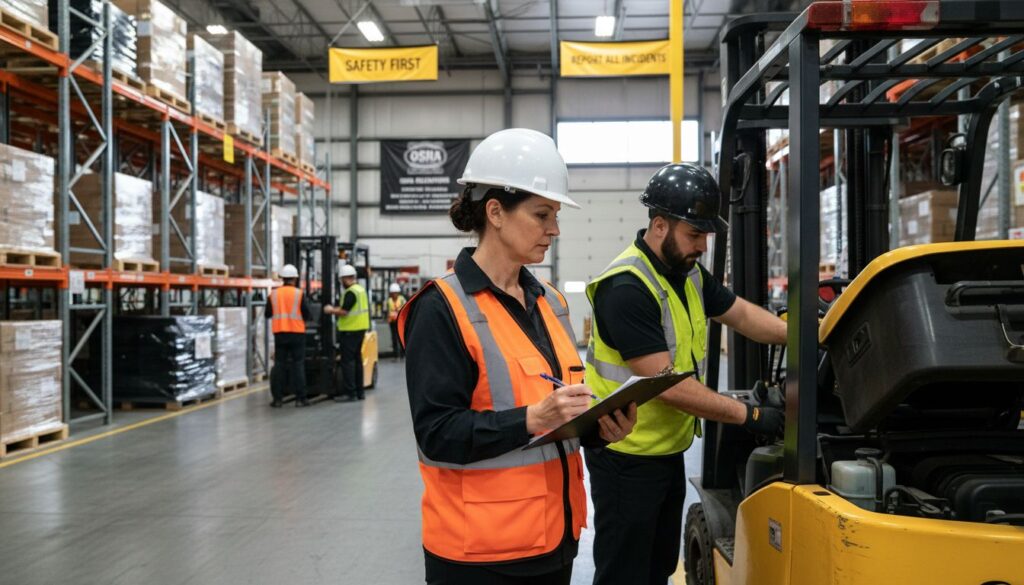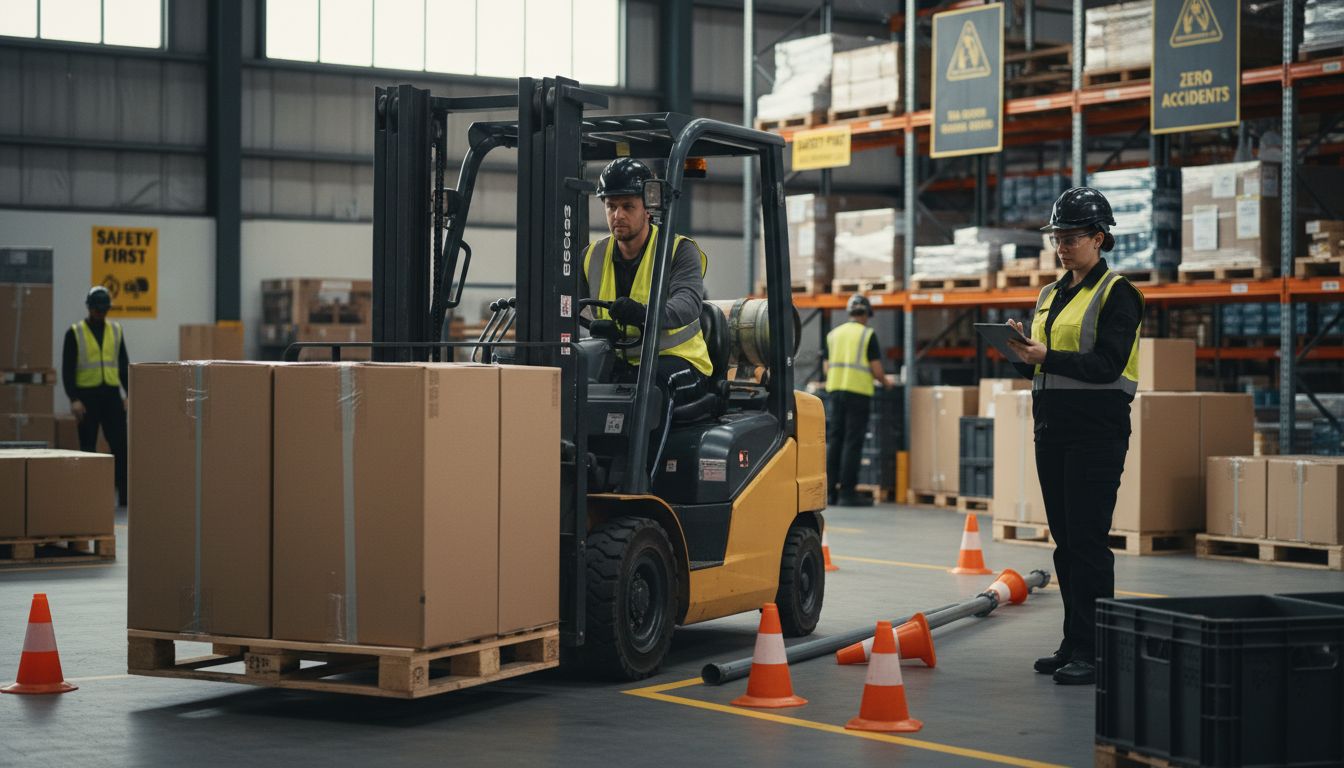
Every american workplace that uses forklifts faces real safety challenges. More than 7,000 forklift-related injuries are reported each year, making clear evaluation and certification vital for everyone involved. Understanding the forklift evaluation process can help employers protect staff, stay compliant with regulations, and reduce costly accidents. This guide breaks down the essentials so you can approach forklift training and certification with the knowledge needed to create a safer environment.
| Point | Details |
|---|---|
| Forklift Evaluation Stages | The evaluation process includes pre-operation inspection, practical skills demonstration, and performance evaluation to ensure operator safety and competency. |
| OSHA Compliance Requirements | Employers must adhere to mandatory training, regular evaluations, and maintain comprehensive documentation to meet OSHA standards. |
| Common Operational Risks | Frequent accidents stem from inadequate training, overloading, and distracted operation, emphasizing the need for rigorous safety protocols. |
| Continuous Certification | Forklift certification is an ongoing process requiring periodic recertification and documentation of operator performance and training achievements. |
The forklift evaluation process is a comprehensive assessment designed to ensure operator safety, competence, and regulatory compliance. According to New York State Department of Transportation, this process involves multiple critical components that systematically measure an operator’s ability to handle complex machinery safely and efficiently.
The evaluation typically encompasses three primary stages of assessment: pre-operation inspection, practical skills demonstration, and performance evaluation. As outlined by the Evergreen Safety Council, these stages help verify that operators possess the necessary technical skills and safety awareness to operate forklifts in professional environments. Employers and training managers use these structured evaluations to minimize workplace accidents and ensure regulatory compliance.
Key elements of the forklift evaluation process include:
![]()
Practical training remains the cornerstone of effective forklift evaluation. Operators must demonstrate proficiency in machine control, spatial awareness, and adherence to safety protocols. Most evaluations include supervised practice sessions where candidates perform tasks mimicking real-world workplace challenges, allowing assessors to gauge their competence under controlled conditions.

To support your forklift certification journey, check out our forklift types guide for additional insights into understanding different equipment variations and their specific operational requirements.
OSHA regulations form the critical backbone of forklift safety standards, establishing comprehensive guidelines that protect workers and ensure workplace safety. According to the Washington State Department of Labor & Industries, these legal standards mandate rigorous training, evaluation, and operational protocols for forklift operators across various industrial environments.
Legal compliance requires employers to implement several key requirements:
The legal framework surrounding forklift operation is complex and multifaceted. Wikipedia highlights that OSHA regulations are designed to minimize workplace accidents by establishing strict standards for operator competence, equipment maintenance, and workplace safety protocols. These standards are not merely recommendations but legally enforceable requirements that carry significant penalties for non-compliance.
Employers must understand that forklift safety goes beyond basic training. It involves continuous education, periodic skill reassessment, and maintaining a culture of safety awareness. Violations can result in substantial fines, potential legal actions, and increased workplace risks.
To help you navigate these complex requirements, explore our guide to OSHA compliance for more detailed insights into meeting these critical legal standards.
Forklift operator evaluations are comprehensive assessments designed to systematically measure an individual’s technical skills, safety awareness, and operational proficiency. According to the New York State Department of Transportation, these evaluations encompass multiple critical dimensions that go far beyond simple operational checks.
The assessment typically involves several key evaluation methods:
As outlined by the City of Bangor, assessment criteria are meticulously designed to evaluate multiple competency levels. Evaluators focus not just on technical skills but also on an operator’s ability to maintain safety protocols, understand equipment limitations, and respond effectively to complex workplace scenarios.
Critical assessment elements include load handling techniques, spatial awareness, equipment control precision, and adherence to safety standards. Operators must demonstrate consistent performance across various operational conditions, proving they can manage different loads, navigate challenging environments, and maintain heightened situational awareness.
To further support your understanding of evaluation requirements, check out our OSHA forklift requirements guide for comprehensive insights into meeting professional standards.
Forklift certification is a structured process that requires meticulous documentation and systematic training. Western Illinois University emphasizes the critical importance of maintaining comprehensive records that demonstrate an operator’s competence and compliance with safety regulations.
The certification process typically involves several key steps:
Documentation is a critical component of the certification process. Employers must maintain detailed records that include:
Certification is not a one-time event but an ongoing process of skill maintenance and continuous learning. Operators must typically undergo recertification every three years or after significant workplace incidents, equipment changes, or observed performance issues. This ensures that forklift operators remain current with the latest safety protocols and operational best practices.
To help you navigate the complex certification landscape, explore our key OSHA forklift requirements guide for comprehensive insights into meeting professional standards.
Forklift operations involve significant workplace hazards that demand meticulous attention and proactive safety management. Washington State Department of Labor & Industries highlights the critical importance of understanding potential risks and implementing comprehensive safety strategies to prevent accidents.
Common mistakes that dramatically increase operational risks include:
Risk mitigation requires a multifaceted approach that combines thorough training, consistent equipment maintenance, and a robust safety culture. Operators must develop heightened situational awareness, understand equipment limitations, and follow strict operational protocols. This means conducting thorough pre-operation checks, respecting load capacities, maintaining clear visibility, and communicating effectively with surrounding workers.
Compliance is not just about following rules but creating a comprehensive safety ecosystem. Employers should implement regular training refreshers, conduct periodic skill assessments, and foster an environment where safety is prioritized over productivity. Potential consequences of non-compliance include substantial financial penalties, increased workplace accidents, and potential legal liability.
For a deeper understanding of navigating these complex safety requirements, explore our comprehensive OSHA forklift requirements guide to ensure your workplace meets the highest safety standards.
Navigating the detailed forklift evaluation process can feel overwhelming, especially when balancing rigorous OSHA requirements with practical skill testing and certification documentation. Safety and proficiency are your top priorities, and ensuring every step from pre-operation inspection to performance evaluation is completed flawlessly is essential for protecting your workplace and staying compliant. This article highlights the need for thorough training and proper evaluation to avoid costly mistakes and legal risks.

Take control of your forklift certification journey today by exploring our expert-driven training and evaluation resources at Forklift License Archives. Our programs combine thorough theoretical knowledge with hands-on practice to help you meet and exceed OSHA standards while ensuring your team is prepared for real-world challenges. Visit Forkliftacademy.com now to unlock efficient certification pathways and safeguard your workforce with industry-leading training solutions. For continuous improvement and safer operations, also check out our Forklift Safety Archives and keep safety your top priority every shift.
The forklift evaluation process is a comprehensive assessment that ensures an operator’s safety, competence, and compliance with regulations. It typically includes stages like pre-operation inspection, practical skills demonstration, and performance evaluation.
Key components include comprehensive equipment knowledge assessment, detailed pre-operation safety checks, hands-on operational skill demonstration, load management understanding, and ability to navigate complex workplace scenarios.
Forklift operators should typically undergo recertification every three years or after significant workplace incidents or equipment changes to ensure they remain current with safety protocols and operational best practices.
Common mistakes include inadequate training, overloading equipment, poor maintenance, distracted operation, and improper load handling, all of which can significantly increase operational risks.